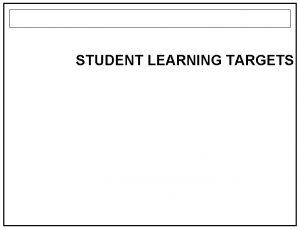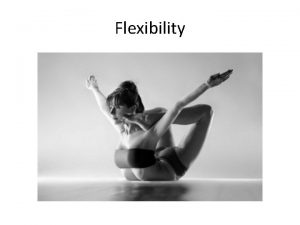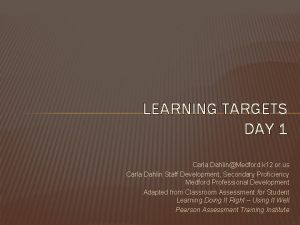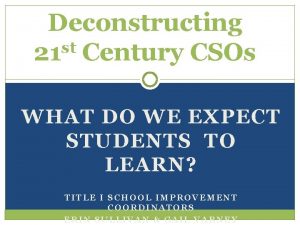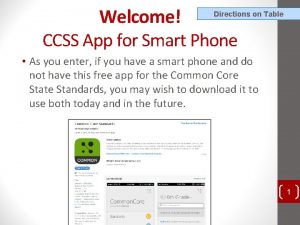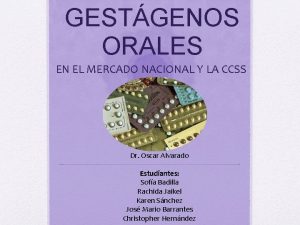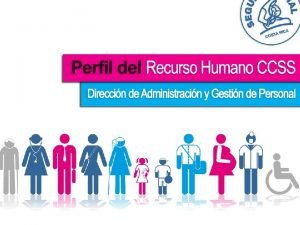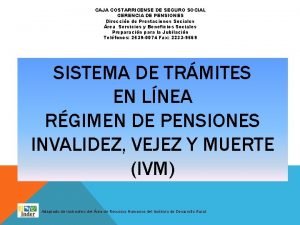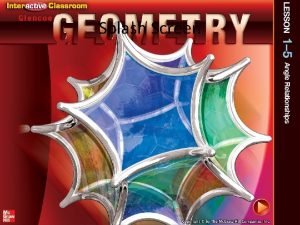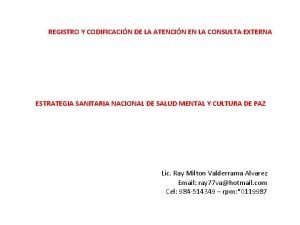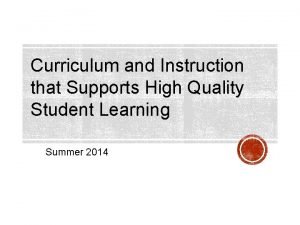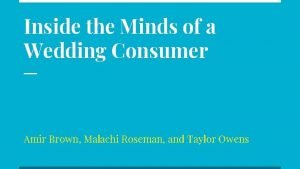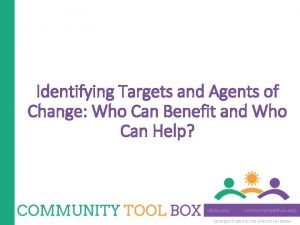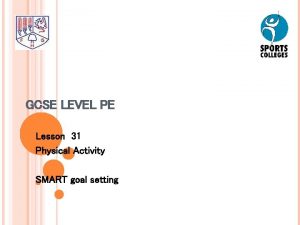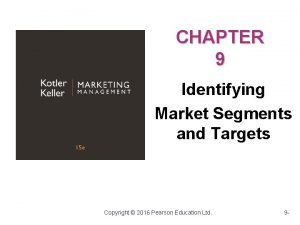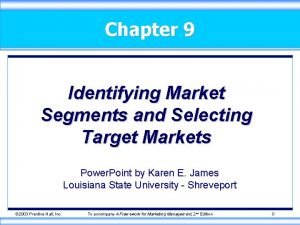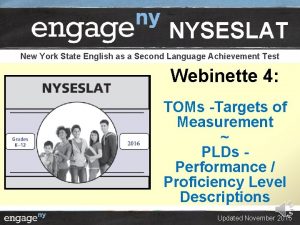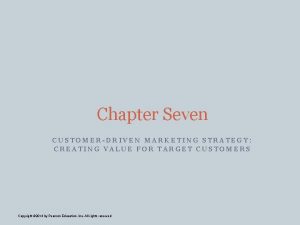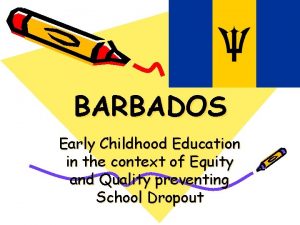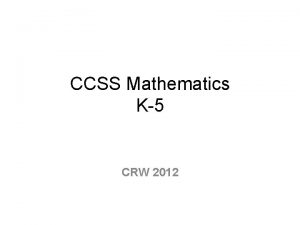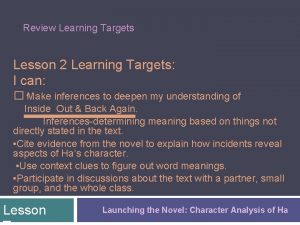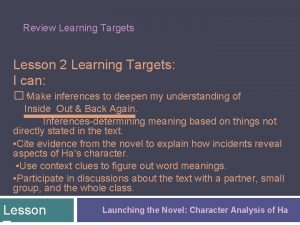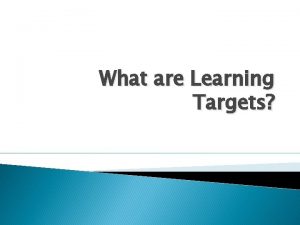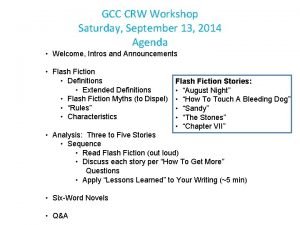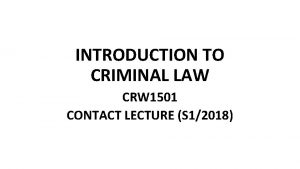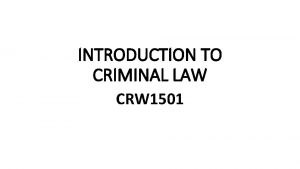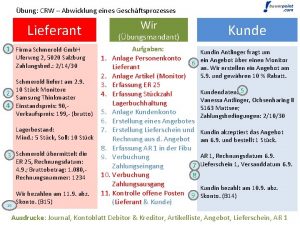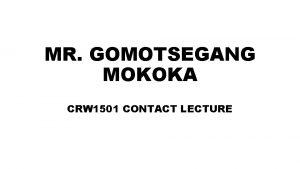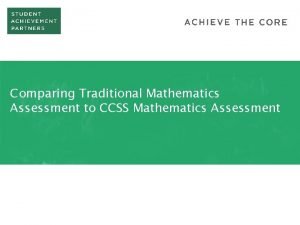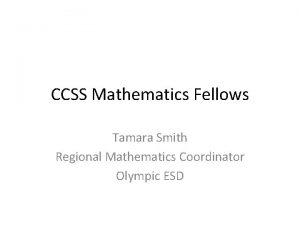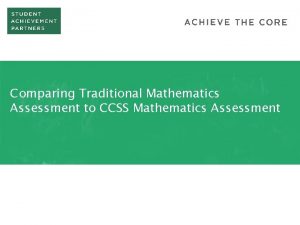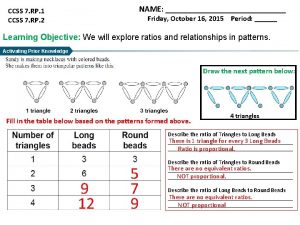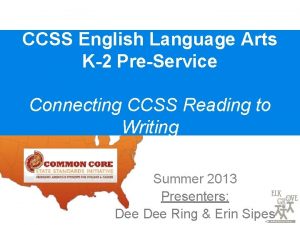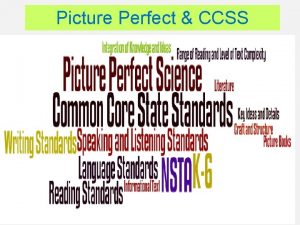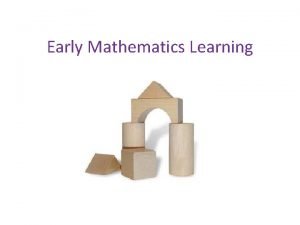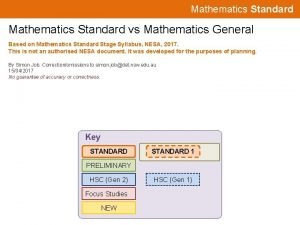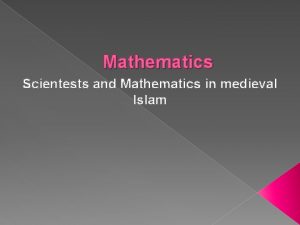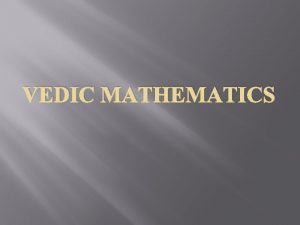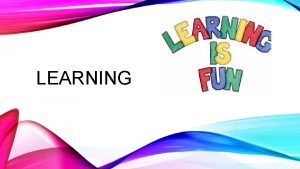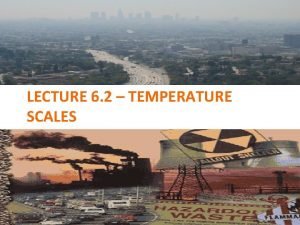CCSS Mathematics K5 CRW 2012 Todays Learning Targets


























- Slides: 26

CCSS Mathematics K-5 CRW 2012

Today’s Learning Targets • I can understand that CCSS math standards requires a different type of teaching, which also requires a different type of assessing. • I can understand that this different way of teaching and assessing has an impact on the work that we will be doing this week, as we create (3 rd-5 th) and revise (K-2 nd) our Baseline and Benchmark Assessments.

Math Shifts teachers & students: • Focus- Teach less, go deeper • Coherence- Build on previous learning and connect concepts • Rigor- Balance of conceptual understanding, procedural skill and fluency, and application of skills in problem solving situations

When planning, ask “What task can I give that will build student understanding? ” rather than “How can I explain clearly so they will understand? ” Grayson Wheatley, NCCTM, 2002

Teaching for Understanding Through Cognitive Demand The kind and level of thinking required of students to successfully engage with and solve a task.

Cognitive Demand Spectrum MEMORIZATION PROCEDURES WITHOUT CONNECTIONS TO UNDERSTANDING, MEANING, OR CONCEPTS Tasks that require memorized procedures in routine ways PROCEDURES DOING WITH MATHEMATICS CONNECTIONS TO UNDERSTANDING, MEANING, OR CONCEPTS Tasks that require engagement with concepts, and stimulate students to make connections to meaning, representation, and other mathematical ideas

Depth of Knowledge Level 1: Recalling and Recognizing Student is able to recall routine facts of knowledge and can recognize shape, symbols, attributes and other qualities. Level 2: Using Procedures Student uses or applies procedures and techniques to arrive at solutions or answers.

Depth of Knowledge Level 3: Explaining and Concluding Student reasons and derives conclusions. Student explains reasoning and processes. Student communicates procedures and findings. Level 4: Making Connections, Extending and Justifying: Student makes connections between different concepts and strands of mathematics. Extends and builds on knowledge to a situation to arrive at a conclusion. Student uses reason and logic to prove and justify conclusions.

Balance Defined “WHERE” THE MATHEMATICS WORK Problem Solving DOING MATH Computational & Procedural Skills Conceptual Understanding “HOW” THE MATHEMATICS WORK “WHY” THE MATHEMATICS WORK

Understanding the Math • The “Why” behind the math- students need to know why and be able to explain why! • Develop the concept then teach the procedure that goes along with that. Concrete Representational Abstract

Timeline for Common Core Mathematics Implementation Common Core State Standards Adopted June, 2010 Year Standards To Be Taught Standards To Be Assessed 2011 – 2012 2003 NCSCOS 2012 – 2013 CCSS (NC) 2013 – 2014 CCSS (NC) 2014 – 2015 CCSS (SBAC)

Let’s look at a familiar problem…

Which of the following represents a. b. c. d. ?

Same problem- a new twist…

For numbers 1 a – 1 d, state whether or not each figure has of its whole shaded. 1 a. ο Yes ο No 1 b. ο Yes ο No 1 c. 1 d. ο Yes ο No

Turn and Talk • This item is worth 0 – 2 points (depending on the responses). – What series of Yes and No responses would a student earn • 2 points? • 1 point? • 0 points?

For numbers 1 a – 1 d, state whether or not each figure has of its whole shaded. 1 a. ο Yes ο No 1 b. ο Yes ο No 1 c. 1 d. ο Yes ο No

For numbers 1 a - 1 d, state whether or not each figure has of its whole shaded. 2 points: YNYN 1 point: YNNN, YYYN 0 point: YYYY, YNNY, NNNN, NNYY, NYYN, NYNN NYYY, NYNY, NNYN, NNNY, YYNY, YNYY

Let’s Do Some Math!

Sample Open-Response Question In the barnyard is an assortment of chickens and pigs. Counting heads I get 13; counting legs I get 46. How many pigs and chickens are there? - Bill Mc. Callum, 2012

Place Value • Complete traditional place value wkst. • Now, look at CCSS worksheet

Base Ten Activity • 160 How many ones do you have? • Using your base ten blocks and your place value mat, show me how to represent 160 • Now, show me how to represent 160 a different way • This example could be used in K-5 (different numbers) • Kindergarten calendar example

Place Value- Table Talk • Traditional worksheet vs Common Core worksheet • What do you notice?


Assessments • Assessment Specifications Summary is in your CRW folders and on our ISS Common Core wiki to guide you as you create your Baseline and Benchmarks.

Thank You!! • Let’s put our brains to work, creating quality baselines and benchmarks that reflect the teaching and understanding of the CCSS!!
 Writing learning targets
Writing learning targets Learning targets
Learning targets Rough sketch and final sketch
Rough sketch and final sketch Reasoning learning targets examples
Reasoning learning targets examples Learning targets knowledge, reasoning, skill product
Learning targets knowledge, reasoning, skill product Learning target
Learning target Ccss app
Ccss app Primafen costa rica
Primafen costa rica Organigrama ccss
Organigrama ccss Gerencia de pensiones ccss
Gerencia de pensiones ccss Ccss splash
Ccss splash Test de tamizaje para adolescentes de la ccss
Test de tamizaje para adolescentes de la ccss Ccss jpams
Ccss jpams Cuadro comparativo de e-learning b-learning y m-learning
Cuadro comparativo de e-learning b-learning y m-learning Objective of warehouse
Objective of warehouse Jim crow laws in what region or regions did it exist
Jim crow laws in what region or regions did it exist Brides magazine targets consumers who are in
Brides magazine targets consumers who are in Targets of change
Targets of change Smart targets pe
Smart targets pe Identifying market segments and targets chapter 9
Identifying market segments and targets chapter 9 Identifying market segments and targets
Identifying market segments and targets Identifying market segments and targets chapter 9
Identifying market segments and targets chapter 9 Nyseslat proficiency levels
Nyseslat proficiency levels A firm that uses blank segmentation divides
A firm that uses blank segmentation divides Attainment targets barbados
Attainment targets barbados Four levels of micromarketing
Four levels of micromarketing Physical targets
Physical targets
